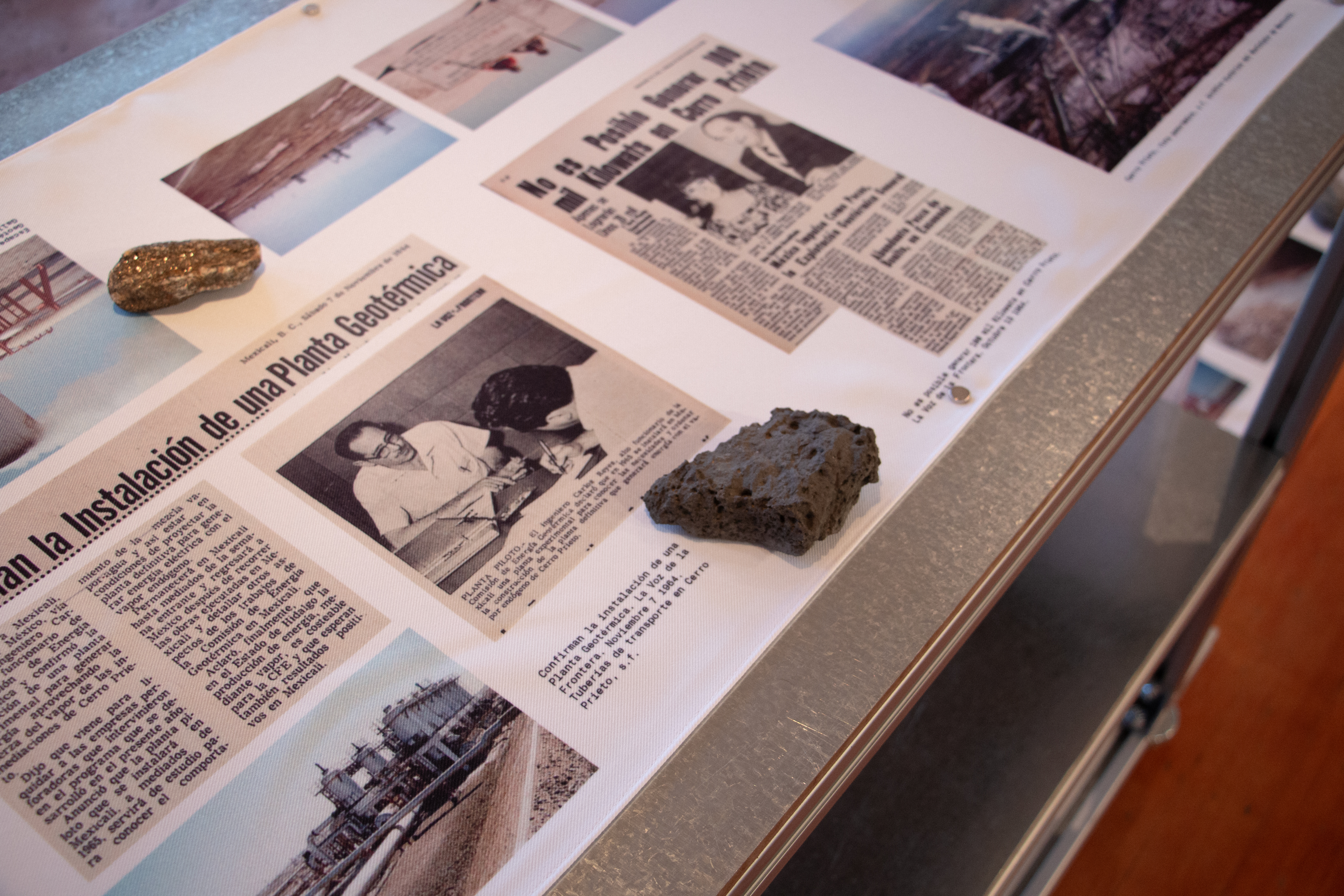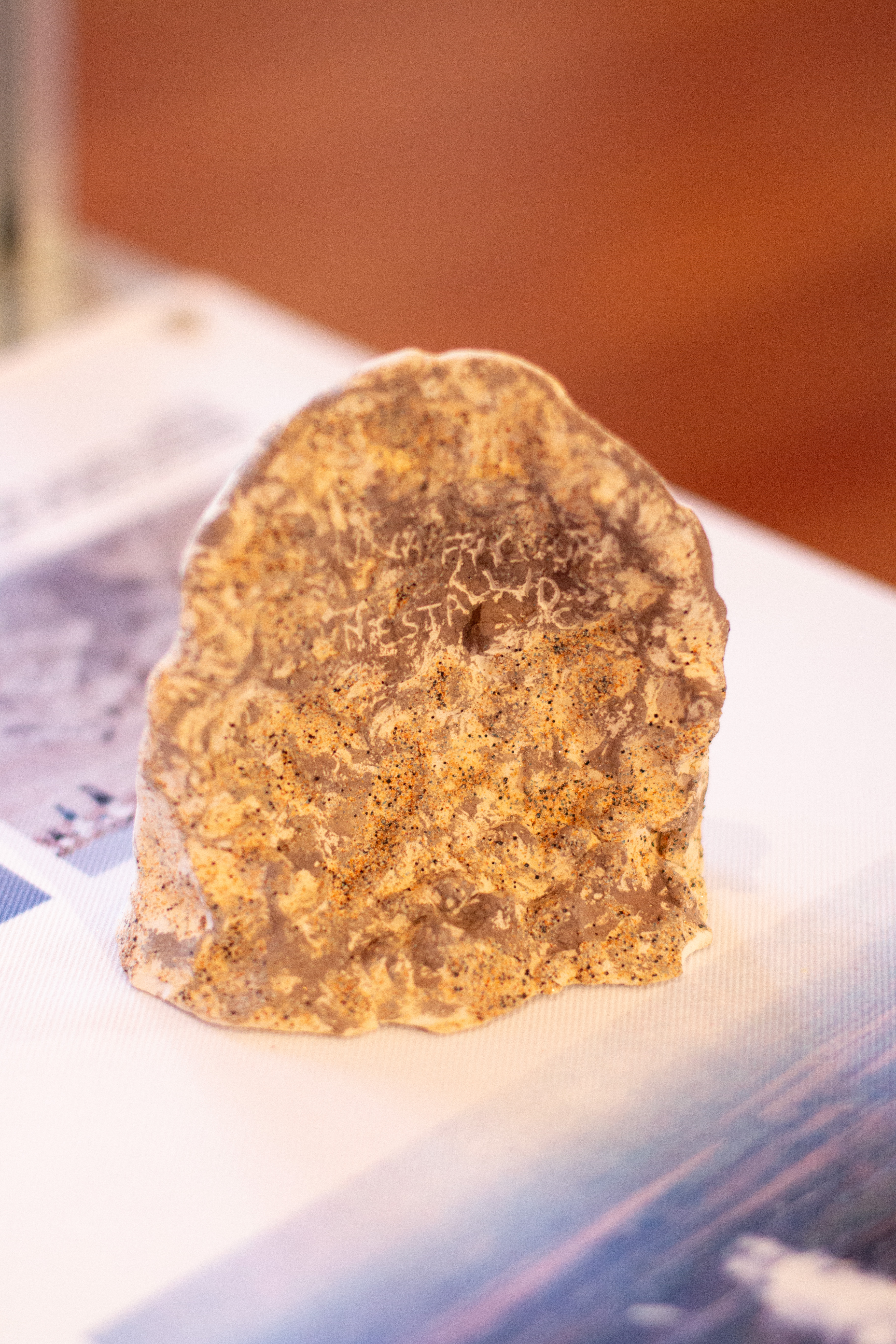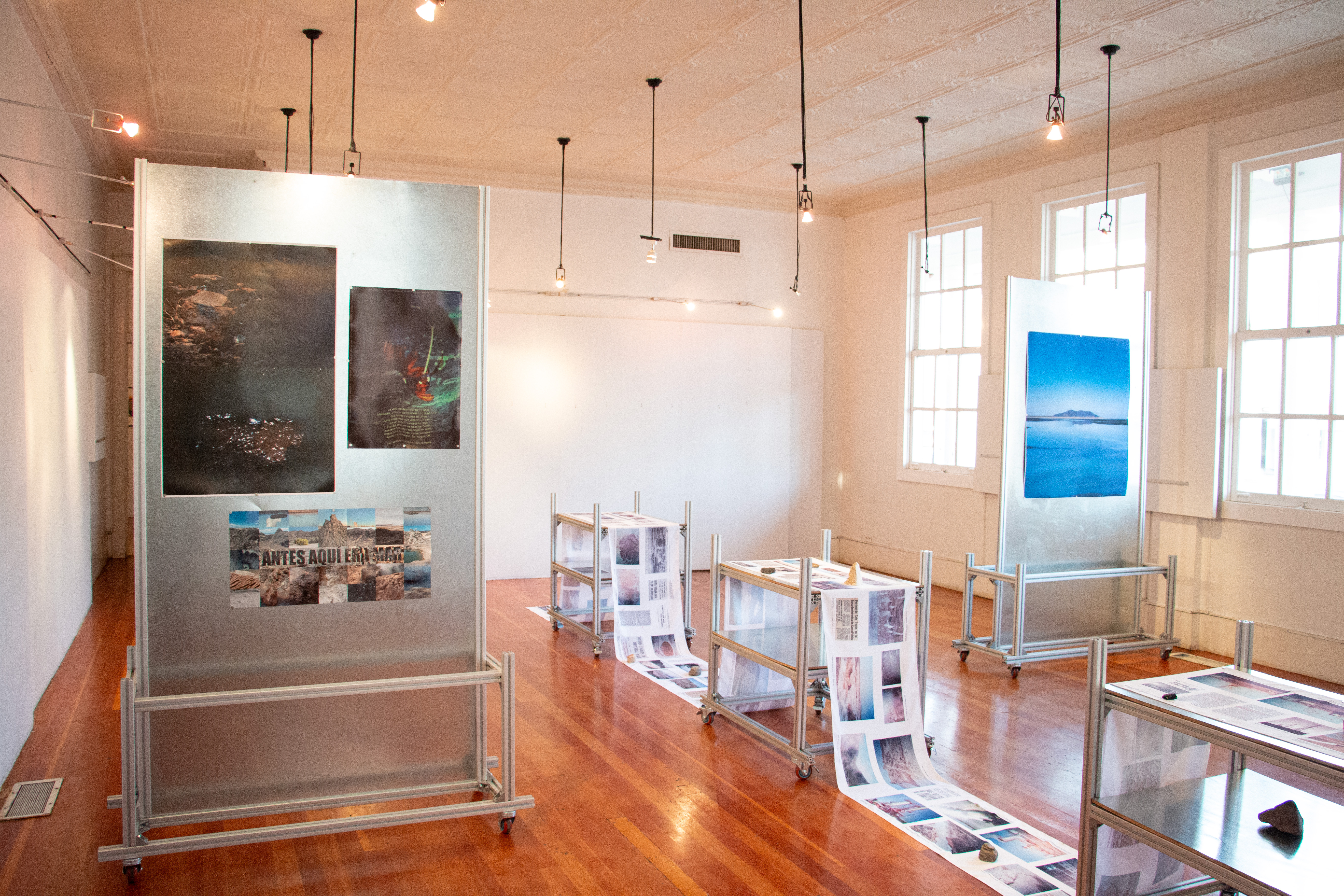LA HUELLA DEL (AGUA) TIEMPO EN FORMA DE GRIETA
THE TRACE OF (WATER) TIME IN THE FORM OF CRACK
Collective exhibition
04.14.2024-06.06.2024
Planta Libre Espacio Experimental
Mexicali, México


This exhibition brought together the network of people who constitute and think with Archivo Familiar del Río Colorado, as well as a diversity of documentary materials that have been compiled over the last three years: from images of families in the canals of the Mexicali Valley, historical photographs of the Río Nuevo, our records in the lagoon system, maps from the last century, as well as chronicles of explorers and settlers in the Delta.
La huella del (agua) tiempo en forma de grieta presents a collective investigation and the reflections of fifteen participants who use the artistic field to explore their experiences of territory and landscape. The work is based on fiction, experimentation, and affective experience that arose from the previous project Invocaciones al agua entre los cerros. Since May 2022, artist Enero y Abril has guided and accompanied the artistic processes that emerged from the series of walks carried out at the confluence of the river and the Laguna Salada, and in some canyons of the Sierra Cucapá and Sierra Juárez, which surround the dry basin of the lagoon; urging the interpretation of fissures and crevices, both in the bodily experience and in the landscape.
Curated by Jessica Sevilla, Rosela del Bosque and Enero y Abril.
Title and curatorial text: Jessica Sevilla
Program and activities: Jessica Sevilla and Rosela del Bosque
Poster design: Rosela del Bosque
Production and funding: Jessica Sevilla
Museography: Minoru Kiyota, Enero y Abril, Jessica Sevilla and Rosela del Bosque
Images: Mayté Miranda
Publication:
Editorial design: Chao Chato and Enero y Abril
Press: Taller de Impresiones
With the support of the Patronato de Arte Contemporáneo A.C.
 Exhibition view
Exhibition view
 Collage map pin-pointing in which landscape and/or body of water each participant developed their artistic research. Design: Jessica Sevilla
Collage map pin-pointing in which landscape and/or body of water each participant developed their artistic research. Design: Jessica Sevilla
Azul&Adoette, Pozo 8, Experimental video, 1:48 min, 2024
 Mauricio Villa, Rancho Los Olivos. Digital photography and found wood ensemble. 160 x 90 cm. 2024
Mauricio Villa, Rancho Los Olivos. Digital photography and found wood ensemble. 160 x 90 cm. 2024 Jessica Sevilla, Solicitud para el establecimiento de industrias turísticas, de innovación científica y desarrollo económico sustentable en la Laguna Salada. Visual essay and apropiation with institutional archives. 6:56 min. 2024
Jessica Sevilla, Solicitud para el establecimiento de industrias turísticas, de innovación científica y desarrollo económico sustentable en la Laguna Salada. Visual essay and apropiation with institutional archives. 6:56 min. 2024 Hugo Fermé, Contenedor. Video-performance, 7:22 min. 2024
Hugo Fermé, Contenedor. Video-performance, 7:22 min. 2024
 Rosela del Bosque, The Power of Letting Off Steam. DIA and CIA archives with archival images of the Cerro Prieto Power Station. Print on paper. 60 x 120 cm. 2024
Rosela del Bosque, The Power of Letting Off Steam. DIA and CIA archives with archival images of the Cerro Prieto Power Station. Print on paper. 60 x 120 cm. 2024
Enero y Abril, El regimen del polvo. Video. 3:52 min. 2024
ON THE OVERFLOW FORMS OF THE COLORADO RIVER DELTA
LOS DESBORDAMIENTOS EN EL DELTA DEL RÍO COLORADO
 Cerro Prieto volcano. 35mm photograph taken in Cerro Prieto Geothermal Power Station CFE in 2024.
Cerro Prieto volcano. 35mm photograph taken in Cerro Prieto Geothermal Power Station CFE in 2024.
On the Overflow Forms of the Colorado River Delta is an ongoing research and exhibition project that addresses the geology of the Delta and hydrogeological memories in Mexicali. It seeks to recognize and trace the consequences of systemic extractivism under a geological reading: from the time-space scales, loss of geological phenomena, the domination and control over water and energy, and how it interacts with present ecologies in the Lower Colorado River region.
The reflection arose from the known overflow forms of the Colorado River: Volcano Lake, the Cerro Prieto extinct volcano, and the Cerro Prieto Geothermal Power Plant, and the Salton Sea region. “On Overflows Forms of the Colorado River Delta” is part of Archivo Familiar del Río Colorado—a collaborative project and growing community archive that seeks to gather, give visibility, and rewrite the intimate stories of our human-river relationship, primarily but not exclusively in the Delta region. This curatorial project aims to present a series of works developed by local artists that connect with deep listening, photography, moving images, and archival materials.
As part of the curatorial process for this first exhibition, “On the Overflows” has taken form into a series of sound explorations and walks focused on geothermal phenomena like geysers, and mud volcanoes and visits with artists to the Geothermal Power Plants in Imperial Valley, CA, and Mexicali. This exhibition and collective artistic research has been developed with Mexicali-based artists Karina Villalobos, Jessica Sevilla, Hugo Fermé, Pastizal Zamudio, Mayté Miranda, and California-based Cynthia Hopper.
ON THE OVERFLOW FORMS OF THE COLORADO RIVER DELTA:
CERRO PRIETO
Collective exhibition and archival research presentation
20-28.06.2024
@ Casa de la Cultura Mexicali
Mexicali, Mexico

Cynthia Hopper
Hugo Fermé
Jessica Sevilla
Karina Villalobos
Pastizal Zamudio
Mayté Miranda
Like rocks, volcanoes hold silences that speak more than language. Although some volcanoes appear inanimate, they express themselves through ruptures, rumblings, and slides that span large stretches of time. The extinct Cerro Prieto volcano has a complex language of its own. It is surrounded by a fault system that opens up the earth with phenomena such as fumaroles, geysers, and mud volcanoes. This geological landscape moves in affinity with the water of the Colorado River. With each overflow, the volcanoes spewed lava, mud, and fire into the air, simultaneously creating fields surrounded by sulfurous vapors. It was a coalescence of natural forces in constant dialogue.
However, with energy extraction from the geothermal field, these manifestations have been irreversibly interrupted. In the 1970s, Cerro Prieto transitioned from being a volcano to becoming one of the first geothermal energy systems in the world, now producing a significant amount of electricity that powers the state of Baja California. Through archival research and explorations, this exhibition presents the different geological temporalities that form the Cerro Prieto landscape, from its deep past to its current state.
As part of the curatorial process, six artists were invited to collectively explore sites such as the geyser in the Sierra Cucapá, the Cerro Prieto Geothermal Power Plant, and the mud volcanoes in the Imperial Valley. These explorations triggered reflections on geological listening, personal experiences in these sites, and the water-energy relationship that continues to articulate these landscapes.
Curation and research: Rosela del Bosque
Exhibition design: Sofía Aguirre
Poster design: Rosela del Bosque
Sound edit: SACH.
Images: Sigfredo González
With the support of Secretaria de Cultura de Baja California through Programa de Estímulos a la Creación y Desarrollo Artístico (PECDA) Baja California 2023-24.
This curatorial project is part of Archivo Familiar del Río Colorado.
 Exhibition view of the recollected archival materials on Cerro Prieto and the Salton Sea region.
Exhibition view of the recollected archival materials on Cerro Prieto and the Salton Sea region.  Close-up of the archival materials and rocks recollected. The title “They Confirm Installation of the Geothermal Plant” with images and volcanic rock from the Cerro Prieto crater.
Close-up of the archival materials and rocks recollected. The title “They Confirm Installation of the Geothermal Plant” with images and volcanic rock from the Cerro Prieto crater.
 View of the archival and photographic materials taken from the Cerro Prieto volcano. In the foreground, is the video by artist Cynthia Hopper titled “Cerro Prieto Geothermic Power Plant”.
View of the archival and photographic materials taken from the Cerro Prieto volcano. In the foreground, is the video by artist Cynthia Hopper titled “Cerro Prieto Geothermic Power Plant”.
“Cerro Prieto Geothermic Power Plant” two-channel video by artist Cynthia Hopper.


Close-up to a ceramic sculpture titled “What secrets does a fracture reveal, a burst?” by artist Mayté Miranda.

 Closeup to a series of analog photographs taken in the Cucapá Geyser printed over acetate by artist Pastizal Zamudio titled “Destierro”.
Closeup to a series of analog photographs taken in the Cucapá Geyser printed over acetate by artist Pastizal Zamudio titled “Destierro”. 
“Once upon a time in la Laguna Volcano” by artist Karina Villalobos. Photograph printed on plotter of Volcano Lake taken in the Cerro Prieto Geothermal Power Plant.
 During the 1970s to 1990s, various U.S. intelligence agencies, including the DIA and CIA, trained people with alleged paranormal abilities to obtain information about threats to the United States. The SUN STREAK program focused on two practices: psychokinesis (physical actions through mental powers) and remote viewing (perceptions unexplainable by known sensory means). The objective was to gather information on science, technology, inaccessible sites, and nuclear weaponry. Between 1988 and 1991, two agents conducted remote viewing exercises from Cerro Prieto Geothermal Power Plant. This series of drawings and notes depicted a vibrant and explosive landscape.
During the 1970s to 1990s, various U.S. intelligence agencies, including the DIA and CIA, trained people with alleged paranormal abilities to obtain information about threats to the United States. The SUN STREAK program focused on two practices: psychokinesis (physical actions through mental powers) and remote viewing (perceptions unexplainable by known sensory means). The objective was to gather information on science, technology, inaccessible sites, and nuclear weaponry. Between 1988 and 1991, two agents conducted remote viewing exercises from Cerro Prieto Geothermal Power Plant. This series of drawings and notes depicted a vibrant and explosive landscape. 


Photograph by artist Hugo Fermé titled “Órganos terrestres”. The images show the heat and depth of the geyser in Sierra Cucapá; “Illustration of comment on timescales; Visual interpretation of conversation with Ing. Victor Gallardo” photograph by artist Jessica Sevilla. ”The Cahuilla Seismic Sea Graphical” intervened photograph by artist Jessica Sevilla. This image is an interpretation from a conversation with Ing. Victor Gallardo, a geologist who works in the Cerro Prieto Geothermal Power Plant.
 Frontal exhibition view.
Frontal exhibition view. ARCHIVO FAMILIAR DEL RÍO COLORADO

Archivo Familiar del Río Colorado is a project coordinated by Jessica Sevilla, Mayté Miranda, and Rosela del Bosque that has worked in close collaboration with Enero y Abril since 2021, Leslie García since 2020, Minoru Kiyota, and recently with Hoshi André Ramirez. The collective was formed in 2020 in Mexicali by conducting fieldwork and documental research for a year before launching to the public in 2021.
Archivo Familiar del Río Colorado is a collaborative project that explores the relationships between people, ecosystems, settlements, and water in the Colorado River deltaic region. It seeks to produce, collect, and edit documental registers, emphasizing the family archive, and investigate how memory is constructed through contingent relationships with water. It uses the artistic field to explore different experiences of territory and landscape; from the affections, fiction, and experimentation; considering the asymmetrical tensions that operate in Mexicali and the US/Mexico border at geopolitical, institutional, and corporal scales. The project is based in Mexicali, Mexico, and has been expanding since its launch in 2021. It began as an Open call and is now a platform for artistic research projects, curatorial work, and the intersection between contemporary art, ecological crisis, and community-building. Archivo Familiar del Río Colorado consists of various interrelated activities: we launch open calls, archive, organize walks, public events, talks, and workshops, curate exhibitions, and publish zines. We work with local and international institutions, universities, collectives, researchers, and artists.is a growing community archive that seeks to gather, give visibility, and rewrite the intimate stories of our human-river relationship— primarily but not exclusively, in the delta region.
The project launched in 2020 with an ongoing open call for family images, fiction, and oralities on the deltaic region of the Colorado River.
If you have any archive, story, or memory to share, please send your materials to the email: archivofamiliardelriocolorado@gmail.com





GLOSSARY PAST FUTURE PRESENT
OF THE COLORADO RIVER

This glossary is an ongoing project where I’ll be constantly adding new words, terms, non-human fellows, treaties/geopolitical undoings, natural phenomena, histories of sub-basins of the Delta region, and beyond ︎
The first edition was presented as part of the Mexicali Biennial “Land of Milk and & Honey” on view at the Cheech Marin Center for Chicano Art and Culture of the Riverside Art Museum.
Download the Glossary here.